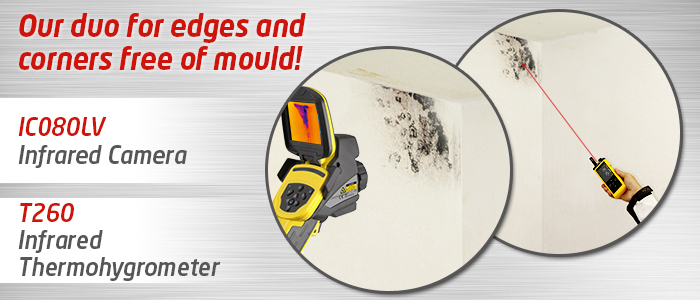
Why does mould always first appear in the corners of a room? And what does this have to do with the notorious “thermal bridges”? You’ll find the answer to these questions in our latest blog – including tips on how you can track down potential risk areas for mould growth in all corners of your home, with help of our two innovative devices…
Mould likes to settle on wall surfaces when humidity values are at 70 to 85 percent. This is because the surface temperature of the interior walls drops causing condensation to form. At this, the rule of thumb applies: If the surface temperature of an interior wall falls to a dew point temperature below 12 dagrees Celsius – the room temperature is about 22 dagrees Celsius and the relative humidity is about 55 percent – condensation can be expected!
The T260 Infrared Thermohygrometer – a one-stop solution!
Humidity, surface temperature of walls, dew point temperature – if you want to carefully monitor all of this, you’ll need a whole range of measuring devices. Or you could simply reach for the T260 Infrared Thermohygrometer: With this, you can measure the relative, absolute and specific air humidity as well as the air temperature, and with the extra integrated laser pyrometer including a dew point alarm, you can detect a fall below the dew point and determine the surface temperature of interior walls. Everything you need in just one innovative measuring device!
Thermal bridges increase the risk of mould growth!
To guard against mould growth, wall surface temperatures must be sufficiently high. However, when it comes to this deceptively simple insight, as usual, the devil is in the detail.
This is because the dreaded thermal bridges (which are feared with good reason) now come into play. Let us explain: Thermal bridges are those parts or areas of a building that conduct heat out of the building more quickly than other structural elements. Due to this effect, parts of the building can cool down too much, easily falling below 12 degrees when outdoor temperatures are low. Such thermal bridges are predominately located in the corners or in projections of houses. They are also called ‘geometric thermal bridges’, because within these corners, the smaller interior surfaces meet the larger exterior surfaces, allowing heat to continually escape.
And that explains why mould tends to emerge in the corners first: because the surfaces of the walls at these thermal bridges partially cool down so much that condensation builds up – the ideal conditions for establishing the first mould colony.
The IC080LV thermal imaging camera identifies thermal bridges!
But you don’t have to let it get to that stage in the first place. Our IC080LV thermal imaging camera enables you to easily identify the thermal bridges – irrespective of whether they are determined by geometry, materials or construction. The camera provides the highest precision due to its very high geometric resolution, temperature measurement range from -20 °C to +600 °C and high thermal sensitivity of 0.05 °C. And using the camera of course also enables you to record the effective insulation in your home. Or you can use it to identify areas for improvement.
Now find out more about our successful duo!
Don’t give mould a chance: with the multi-functional T260 Infrared Thermohygrometer and the highly-sensitive IC080LV Thermal Imaging Camera, you’ll be fully equipped – for more information on both of these innovative devices, visit the Trotec-Shop!
On top of that, our thermal imaging camera is also available to hire, naturally also at favourable conditions .

